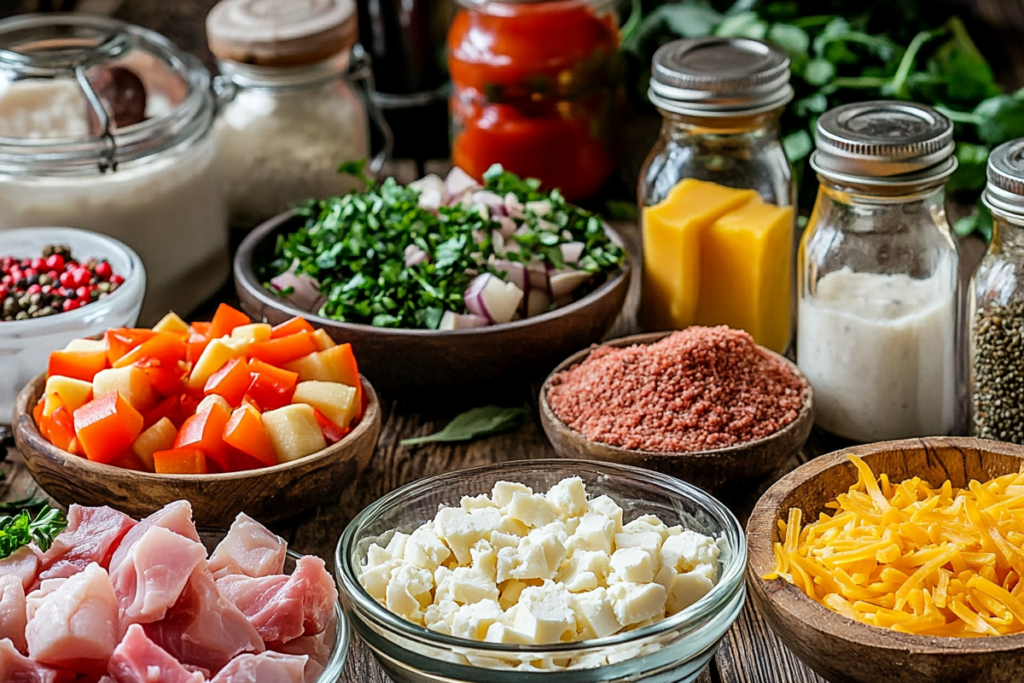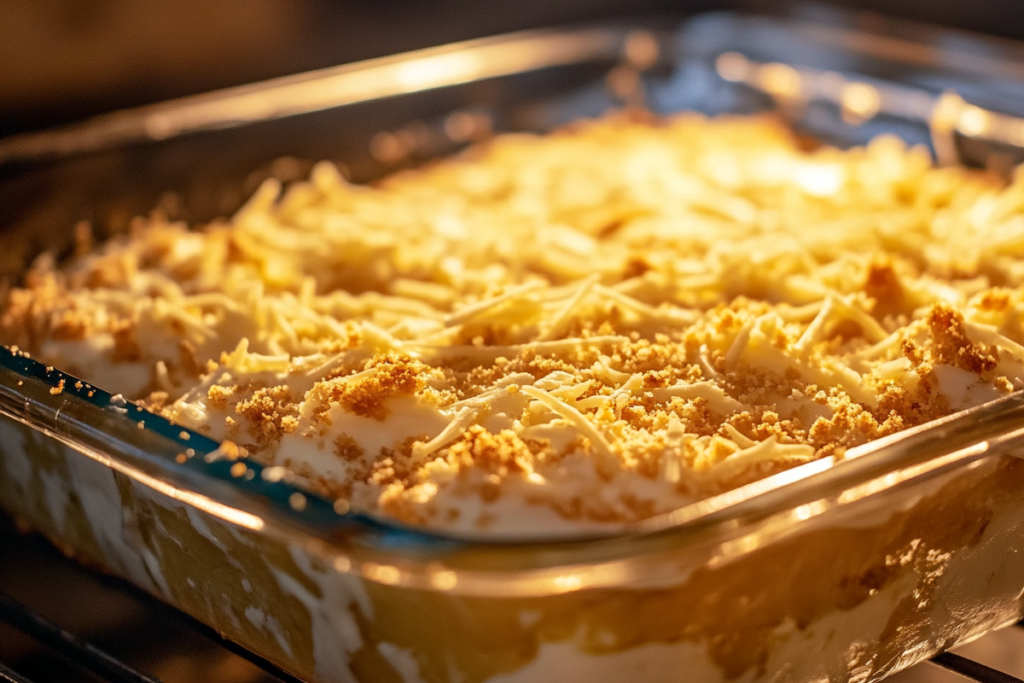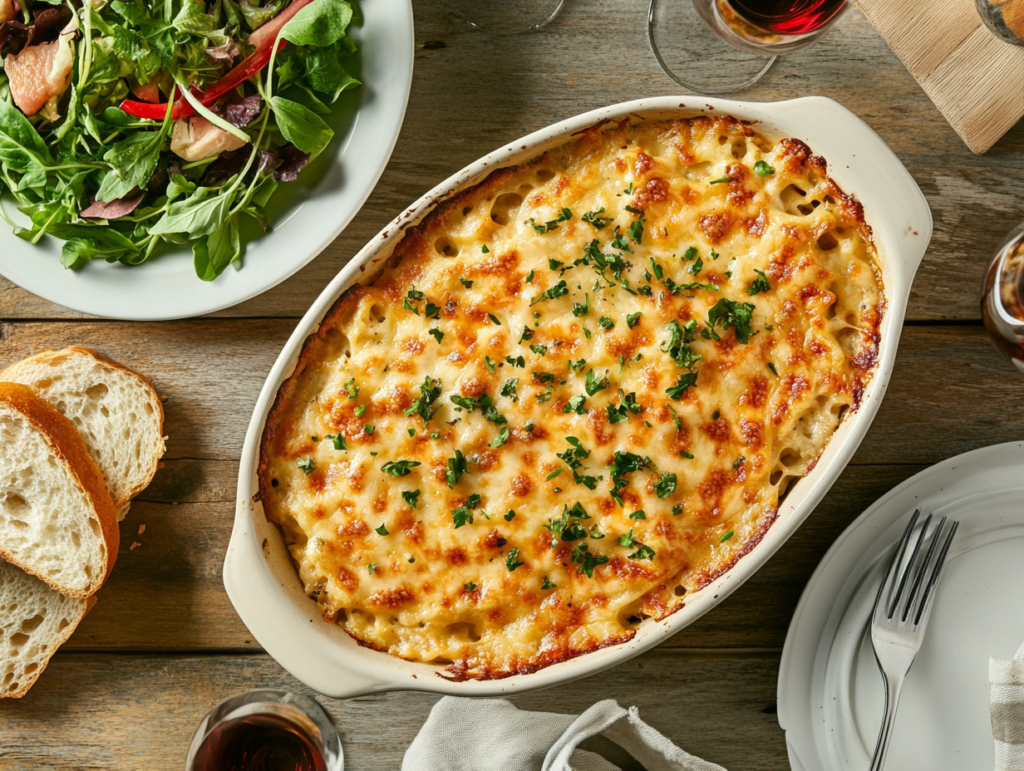
What is the Key to Making a Good Casserole? Tips & Secrets
Discover the art of crafting the perfect casserole with a step-by-step guide to ingredients, preparation techniques, cooking tips, and serving suggestions. Dive into the secrets of balancing flavors, achieving the ideal texture, and avoiding common pitfalls to master this comforting, versatile dish.
Introduction
Casseroles have been a staple of comfort food for generations, offering versatility and heartiness in every bite. Whether you’re preparing a weeknight family dinner or a dish for a special occasion, knowing what makes a good casserole can elevate your culinary skills. From selecting the right ingredients to mastering cooking techniques, this guide explores every detail. So, grab your apron and let’s uncover the secrets to casserole perfection.
Part 1: Understanding the Essence of a Good Casserole
Definition and Historical Background
Casseroles are more than just a collection of ingredients baked together—they’re a celebration of creativity, flavor, and practicality. Historically, the term “casserole” refers to the deep dish used for cooking. The concept itself, though, dates back centuries, when people sought efficient ways to prepare nourishing, hearty meals.
In modern cuisine, casseroles have taken center stage as one-dish meals, merging proteins, vegetables, and starches with delectable sauces and toppings. Their adaptability makes them beloved across cultures and kitchens worldwide.
Popularity and Cultural Significance
Why are casseroles such a universal favorite? Well, their charm lies in their simplicity and the way they bring people together. In homes, casseroles have long been a symbol of warmth and generosity—whether it’s a dish shared at a potluck or one delivered to comfort a friend. From creamy pasta-based dishes in Western households to vegetable-rich variants in Asian kitchens, casseroles embrace cultural diversity with open arms.
For many, casseroles also represent nostalgia—a reminder of family dinners or recipes passed down through generations. They’re not just food; they’re an experience that combines history, flavor, and emotion in every spoonful.
Feel free to provide your feedback or ask me to continue with Part 2!
Part 2: Fundamental Components of a Casserole
Core Ingredients
The foundation of a great casserole lies in its carefully chosen components. Every ingredient should harmonize to create a balanced, flavorful dish. When selecting what to include, think of a casserole as a symphony of protein, vegetables, starch, and binders—all working together to deliver satisfaction in every bite.
Proteins
Proteins provide the heartiness that makes casseroles so filling. From tender cuts of chicken and beef to flaky fish or tofu for vegetarian options, there’s something for everyone. For instance, shredded rotisserie chicken offers convenience without compromising flavor, while lentils or chickpeas can add a protein punch in plant-based casseroles.
- Meat Options: Think diced chicken, ground turkey, or even seafood like cod or shrimp. These bring depth and texture to the dish.
- Vegetarian Alternatives: Beans, lentils, or tofu offer versatility and richness. They’re perfect for those wanting to skip meat without sacrificing substance.
Vegetables
Vegetables are where casseroles shine in versatility. Not only do they add nutrition, but they also infuse the dish with color and texture. Some common picks include carrots, peas, and broccoli. However, seasonal vegetables—like zucchini in summer or squash in fall—can elevate a casserole to something truly special.
- Common Choices: Mushrooms, onions, and spinach are go-to additions for enhancing flavor and texture.
- Seasonal Variations: Incorporating fresh, in-season produce not only boosts taste but also ensures sustainability.
Starches
Starches act as the glue, binding flavors together while providing a satisfying base. They’re the canvas upon which the rest of the casserole is built.
- Pasta, Rice, and Potatoes: Classic options like elbow macaroni, brown rice, or thinly sliced potatoes never go out of style.
- Low-Carb Options: Cauliflower rice or zucchini noodles cater to health-conscious eaters while keeping things delicious.
Part 3: The Role of Sauces and Binders
Importance of Moisture Balance
The secret to a truly satisfying casserole lies in its moisture content. A perfectly balanced casserole isn’t soggy, nor is it dry—it strikes the ideal middle ground. Sauces and binders play a pivotal role in achieving this harmony. They tie all the components together, ensuring every bite is creamy, cohesive, and flavorful.
Cream-Based Sauces
Rich, velvety cream-based sauces are a staple for many classic casseroles. Think béchamel, cheese sauces, or even simple sour cream mixes. These add a luxurious texture and provide a comforting, indulgent feel.
- When to Use: Perfect for dishes like chicken Alfredo casserole or creamy vegetable bakes.
- Tips for Success: Incorporate a blend of heavy cream, milk, or yogurt with melted cheese to achieve the desired consistency. Avoid overheating to prevent separation.
Tomato-Based Sauces
Tomato-based casseroles bring a tangy, savory depth. These sauces pair exceptionally well with pasta or rice casseroles, balancing the richness of cheeses or proteins.
- When to Use: Great for Italian-inspired casseroles, like lasagna or stuffed pepper bakes.
- Tips for Success: Use crushed or pureed tomatoes and season with basil, oregano, or a pinch of sugar to reduce acidity.
Broth and Stock Options
For lighter casseroles, broths and stocks provide flavor without heaviness. Chicken broth, vegetable stock, or even bone broth works well in recipes where cream or tomatoes may overpower the other ingredients.
- When to Use: Best for low-fat casseroles or dishes like chicken and wild rice bake.
- Tips for Success: Opt for low-sodium varieties and enhance them with garlic, thyme, or bay leaves for a homemade touch.
Part 4: Seasoning and Flavor Enhancement
Herbs and Spices
Seasoning is the soul of any casserole, transforming a basic dish into something unforgettable. By carefully selecting herbs and spices, you can enhance natural flavors, create depth, and cater to personal preferences. Whether you prefer traditional seasonings or love experimenting, there’s a world of possibilities.
Traditional Seasonings
Classic casseroles often rely on tried-and-true blends that complement a range of ingredients. These seasonings ensure a well-rounded and universally appealing taste.
- Salt and Pepper: The basics, but essential for bringing out flavors.
- Garlic and Onion Powder: Instant umami boosters for sauces, proteins, or vegetables.
- Italian Seasoning: A versatile mix of oregano, basil, and thyme, perfect for pasta-based casseroles.
Innovative Flavorings
For those who crave a little adventure, non-traditional seasonings can introduce unexpected and exciting dimensions.
- Smoked Paprika: Adds a subtle smokiness, ideal for cheesy or meat-forward casseroles.
- Curry Powder: Lends a bold, aromatic touch to vegetable or lentil-based dishes.
- Lemon Zest or Juice: Brightens flavors, especially in seafood or light vegetable casseroles.
Tips for Balanced Flavor
Balancing flavors is key to avoiding a bland or overpowering casserole. Use contrasting notes—savory, sweet, tangy, or spicy—to create harmony. For instance, a creamy chicken casserole may benefit from a hint of nutmeg or mustard, while a rich lasagna might need fresh basil to lighten its boldness.
Part 5: Toppings and Textural Contrasts
Crunchy Toppings
A good casserole doesn’t just taste amazing—it also needs an enticing texture. The contrast between creamy layers and crispy toppings is what makes every bite satisfying. Adding the right crunchy element can elevate your dish from ordinary to extraordinary.
Breadcrumbs and Crusts
Breadcrumbs are the go-to topping for casseroles that need a golden, crunchy finish. Whether seasoned or plain, breadcrumbs add a subtle, nutty flavor and satisfying bite.
- Classic Options: Panko breadcrumbs, Italian-seasoned breadcrumbs, or crushed crackers.
- How to Use: Combine breadcrumbs with melted butter or olive oil before sprinkling over the casserole for an even, browned crust.
Cheese Varieties
Melted cheese is a fan favorite, but when baked until bubbly and golden, it becomes a showstopper. The gooey interior paired with a lightly crisp cheese crust is unbeatable.
- Best Choices: Cheddar, mozzarella, Parmesan, or Gruyère for bold flavor and excellent melting properties.
- Pro Tip: Mix grated cheese with breadcrumbs for a topping that combines crunch and cheesy goodness.
Creating Layers of Texture
Casseroles with multiple textural layers keep the palate engaged. Adding ingredients like sliced almonds, fried onions, or crispy bacon bits (for non-vegetarian casseroles) as a final touch introduces dynamic contrast to soft and creamy bases.
Part 6: Cooking Techniques
Baking Temperatures and Times
The cooking process is where all the ingredients meld together, creating the cohesive flavors and textures that define a good casserole. But achieving perfection requires attention to baking temperatures and timing. Too hot or too long, and you risk a dry dish; too cool, and the center might not cook through.
Optimal Oven Settings
Most casseroles bake well at a moderate temperature—around 350°F to 375°F. This range allows the layers to cook evenly without scorching the top before the inside is fully heated.
- Tip for Success: Preheat the oven to ensure consistent cooking. For casseroles with a dense base (like potatoes), consider starting at a lower temperature to allow thorough heating, then increasing the heat for a browned topping.
Ensuring Even Cooking
Layering ingredients properly is crucial for even cooking. Proteins should be fully cooked or par-cooked, while vegetables may need pre-roasting or steaming to avoid raw textures. Stirring sauces evenly across the dish before assembly ensures uniform distribution of moisture.
- Tip for Success: If the top is browning too quickly, cover the dish with aluminum foil during the initial bake and uncover for the last 10–15 minutes.
Testing for Doneness
Knowing when your casserole is ready can save it from over- or under-cooking. Signs include a bubbly center, a golden top, and an internal temperature of at least 165°F for protein-based casseroles.
- Pro Tip: Insert a knife into the center of the casserole to check if the middle is hot and the sauce is thickened.
Part 7: Equipment Essentials

Choosing the Right Baking Dish
The success of your casserole isn’t just about the ingredients—it also depends on the baking dish. Using the right dish can make all the difference in cooking time, even heating, and presentation. A good casserole dish ensures your layers cook evenly while also complementing the visual appeal of the meal.
Material Considerations
The material of your baking dish affects how heat is distributed and retained. Some materials work better for certain recipes, so choose wisely based on your dish’s requirements.
- Glass: Glass dishes are excellent for monitoring cooking progress since they’re transparent. They retain heat well but can be prone to uneven cooking at the edges.
- Ceramic: Perfect for creamy casseroles, ceramic dishes offer uniform heat distribution and a rustic look.
- Metal: Metal pans heat quickly and are great for crisping toppings, but they may cause sauces to dry out faster than glass or ceramic.
Size and Shape Implications
The size and shape of the dish determine how your casserole layers bake and whether the dish fits into your oven efficiently.
- Shallow Dishes: Ideal for casseroles with a focus on crunchy toppings, as they allow for maximum surface area exposure.
- Deep Dishes: Great for recipes with thick layers or additional ingredients like meats and vegetables. They keep everything contained and prevent bubbling over.
Additional Tools for Success
While the baking dish takes center stage, a few additional tools can make casserole preparation easier:
- Mixing Bowls: For preparing sauces or tossing ingredients together before layering.
- Sharp Knife and Cutting Board: For precise vegetable and protein prep.
- Aluminum Foil or Lids: To control browning and maintain moisture during baking.
Part 8: Preparation Tips
Assembling Ingredients Efficiently
A well-prepared casserole starts long before it reaches the oven. Taking time to properly assemble your ingredients not only saves effort during cooking but also ensures even distribution of flavors. Plus, having everything prepped in advance makes the process smoother and less stressful.
Pre-Cooking Components
Pre-cooking certain ingredients can make a significant difference in the final dish. Proteins like chicken or beef often need to be browned or cooked through to ensure they’re flavorful and safe to eat. Similarly, harder vegetables, such as carrots or broccoli, may need blanching or roasting to soften them slightly before layering.
- Tip for Success: Use the same pan to sauté vegetables and brown proteins. This not only saves time but also incorporates the rich flavors left in the pan.
Layering Techniques
The way you layer your casserole impacts everything from cooking time to flavor balance. Start with a sturdy base, such as starches or vegetables, to support the rest of the layers. Follow with proteins, then evenly spread sauces to bind the ingredients together. Finally, top it all with cheese, breadcrumbs, or other crunchy elements.
- Pro Tip: Avoid overloading the dish with too many layers, as this can lead to uneven cooking. Stick to 3–5 layers for a perfectly cooked casserole.
Avoiding Ingredient Overlap
Overlapping wet ingredients, like sauces and watery vegetables, can lead to a soggy casserole. Instead, pat dry vegetables and use thickened sauces to maintain structure.
Part 9: Common Mistakes to Avoid
Preventing Overcooking or Undercooking
One of the most common pitfalls in casserole-making is improper cooking. Overcooking can dry out the dish and lead to a rubbery texture, while undercooking can leave raw, unappetizing layers. Striking the perfect balance requires careful attention to cooking time and temperature.
- Tip for Success: Monitor your casserole closely during baking. If it’s browning too quickly on top but the center isn’t done, cover it loosely with foil and continue cooking.
Balancing Ingredients Properly
A well-balanced casserole ensures that no single ingredient overwhelms the dish. Too much starch can make it heavy, while an excess of sauce might turn it into a soggy mess.
- Tip for Success: Use a ratio of approximately 1:1:1 for proteins, vegetables, and starches. This creates a harmonious blend of flavors and textures.
Avoiding Excess Moisture
Moisture control is crucial to achieving a casserole that’s creamy without being soupy. Overly wet vegetables or too much sauce can result in a dish that lacks structure.
- Tips for Reducing Moisture:
- Blanch vegetables and pat them dry before layering.
- Use thickened sauces or reduce broths on the stovetop before adding them to the dish.
- Sprinkle breadcrumbs or cheese between layers to absorb excess liquid.
Neglecting Flavor Development
Even a beautifully layered casserole can fall flat without adequate seasoning. Skimping on herbs, spices, or flavor contrasts is a missed opportunity to make the dish shine.
- Pro Tip: Taste-test components like sauces and proteins before assembling. Adjust seasonings as needed, since layers absorb and redistribute flavors during baking.
Part 10: Customizing Your Casserole
Dietary Modifications
Casseroles are inherently versatile, making them an excellent choice for accommodating various dietary needs. With a few thoughtful substitutions and adjustments, you can create a dish that’s both delicious and suitable for everyone at the table.
Gluten-Free Options
For gluten-sensitive or celiac-friendly casseroles, swapping out traditional ingredients is simpler than you might think.
- Starches: Use gluten-free pasta, quinoa, or rice as a base.
- Thickeners: Replace all-purpose flour with cornstarch or gluten-free flour for sauces.
- Toppings: Opt for gluten-free breadcrumbs or crushed gluten-free crackers for a crispy finish.
Vegan and Vegetarian Adaptations
Plant-based casseroles can be just as hearty and flavorful as their meat-based counterparts. In fact, they often allow the natural sweetness of vegetables to shine.
- Proteins: Use tofu, tempeh, beans, or lentils in place of meat.
- Sauces: Create creamy bases with cashew cream, coconut milk, or a dairy-free béchamel sauce.
- Cheese Alternatives: Top with nutritional yeast or plant-based shredded cheese for that classic casserole finish.
Adding Unique Twists
Customizing casseroles is a great way to cater to specific tastes or experiment with bold new flavors.
- Regional Flair: Add spices like cumin and coriander for a Southwestern twist, or use curry paste for an Indian-inspired casserole.
- Ingredient Swaps: Substitute sweet potatoes for regular potatoes or use spiralized zucchini instead of pasta for a low-carb option.
- Family Favorites: Incorporate beloved ingredients like caramelized onions or roasted garlic to make the dish your own.
Part 11: Serving Suggestions

Pairing with Side Dishes
A casserole, while often a meal in itself, can shine even brighter when paired with complementary side dishes. The right accompaniments enhance the overall dining experience, adding freshness, crunch, or lightness to the rich flavors of a casserole.
Salads and Greens
Fresh salads provide a crisp, refreshing contrast to the heartiness of a casserole. Whether it’s a simple green salad or a more elaborate mix of seasonal vegetables, the lightness of greens balances the richness of the main dish.
- Options: A tangy vinaigrette-dressed arugula salad or a classic Caesar salad pairs wonderfully with creamy casseroles.
- Pro Tip: Include crunchy elements like nuts or croutons to echo the textures in the casserole topping.
Breads and Rolls
Warm, crusty bread or soft rolls are perfect for soaking up any leftover sauce. They’re a comforting addition that enhances the dish’s hearty appeal.
- Options: Garlic bread, sourdough rolls, or whole-grain flatbreads are versatile choices.
- Pro Tip: Brush bread with olive oil and herbs before warming for an aromatic, flavorful touch.
Beverage Pairings
Non-alcoholic beverages can complement the flavors of your casserole while keeping the focus on the food.
- Options: Sparkling water with a splash of lemon, iced tea, or a warm herbal infusion pairs well with many casseroles.
- Pro Tip: Match beverages to the flavor profile—citrusy drinks for light casseroles and spiced teas for rich, savory ones.
Part 12: Storing and Reheating Leftovers
Proper Storage Techniques
Casseroles often yield generous portions, making them an excellent candidate for leftovers. However, proper storage is crucial to preserving their flavor and texture. With the right approach, your casserole can taste just as good—or even better—the next day.
Refrigeration Guidelines
If you plan to eat the leftovers within a few days, refrigeration is your best option.
- Steps:
- Allow the casserole to cool completely before storing.
- Transfer it to an airtight container or cover the dish tightly with plastic wrap or aluminum foil.
- Store in the refrigerator for up to 3–4 days.
Freezing Methods
For longer storage, casseroles freeze exceptionally well. Whether you want to save individual portions or the entire dish, freezing ensures your meal stays fresh.
- Steps:
- Cool the casserole completely to prevent freezer burn.
- Wrap the dish tightly with plastic wrap, followed by aluminum foil, or use freezer-safe containers.
- Label with the date and contents for easy identification.
- Store for up to 3 months.
Reheating Instructions
Reheating a casserole requires care to maintain its original texture and flavor.
In the Oven
- Preheat the oven to 350°F.
- Cover the casserole with foil to prevent the top from over-browning.
- Heat for 20–30 minutes or until the center reaches 165°F.
In the Microwave
- Use a microwave-safe dish.
- Heat on medium power in 1–2 minute increments, stirring occasionally to distribute heat evenly.
Part 13: Popular Casserole Variations
Regional and International Recipes
Casseroles are beloved worldwide, and each culture has its own unique take on this comforting dish. Exploring these variations is a delightful way to expand your culinary horizons while appreciating the diversity of flavors.
Classic American Casseroles
American casseroles are often hearty and family-focused, with recipes passed down through generations. These dishes reflect comfort and simplicity, making them staples at gatherings and potlucks.
- Examples:
- Green Bean Casserole: A Thanksgiving classic with green beans, cream of mushroom soup, and crispy fried onions.
- Macaroni and Cheese Bake: A creamy, cheesy pasta dish with a golden breadcrumb topping.
European Influences
European casseroles often emphasize fresh, simple ingredients and are baked to perfection with a focus on balanced flavors.
- Examples:
- Shepherd’s Pie: A British dish with seasoned ground meat topped with creamy mashed potatoes.
- Moussaka: A Mediterranean casserole featuring layers of eggplant, ground lamb or beef, and a creamy béchamel sauce.
Asian-Inspired Casseroles
Asian flavors bring boldness and variety to casseroles, showcasing spices, sauces, and ingredients that stand out.
- Examples:
- Curry Rice Casserole: A fusion of fragrant spices, rice, and vegetables baked together.
- Teriyaki Noodle Casserole: A combination of stir-fried noodles, vegetables, and a sweet-savory teriyaki glaze.
Custom Variations to Try
Casseroles are also a blank canvas for your creativity. Combining elements from different cuisines, like adding Southwestern spices to a lasagna, can lead to exciting results.
Part 14: Frequently Asked Questions (FAQs)
What is the key to making a good casserole?
The key to making a good casserole lies in achieving balance—using fresh, complementary ingredients, maintaining the right moisture levels, and layering thoughtfully. Proper seasoning and a crisp topping can also elevate the dish from average to exceptional.
Should you cover a casserole when baking?
It depends on the recipe. Covering a casserole traps moisture, which is ideal for dishes prone to drying out. For a golden, crispy topping, uncover the casserole during the last 10–15 minutes of baking.
How do you keep a casserole from drying out?
To prevent dryness, use adequate sauce or liquid to bind the ingredients. Additionally, covering the dish during baking retains moisture. Be cautious not to overbake, as prolonged heat can evaporate essential liquids.
Can you prepare a casserole in advance?
Yes, casseroles are excellent make-ahead meals. Assemble the dish a day before and refrigerate it, covered tightly. Bring it to room temperature before baking or adjust the baking time to account for the chilled starting temperature.
What are some healthy substitutes for common casserole ingredients?
- Sauces: Use Greek yogurt or blended cashews instead of heavy cream.
- Starches: Substitute cauliflower rice or zucchini noodles for pasta or potatoes.
- Cheese: Opt for reduced-fat cheese or nutritional yeast for a dairy-free option.
How do you add flavor to a bland casserole?
Enhance flavor with fresh herbs, spices, or a splash of citrus. Adding layers of seasoning—like seasoning the sauce and the layers individually—ensures every bite is flavorful. A topping of sharp cheese or spiced breadcrumbs can also make a significant difference.
Part 15: Mastering the Art of Casserole Making
Recap of Key Points
Creating a delicious casserole is both an art and a science. From selecting fresh proteins, vegetables, and starches to mastering the role of sauces and binders, every step plays a crucial part in the final dish. Seasoning enhances flavor, toppings provide texture, and proper cooking techniques ensure even results. With tips for avoiding common mistakes, customizing for dietary needs, and incorporating regional inspirations, there’s no limit to the variety and creativity you can bring to your casseroles.
Encouragement to Experiment and Enjoy
A casserole isn’t just a meal—it’s a canvas for your culinary imagination. Whether you’re recreating a classic recipe or exploring international variations, the joy is in the process. Experiment with new ingredients, make it your own, and most importantly, share it with loved ones. After all, the best casseroles are those made with care, creativity, and a dash of love.
